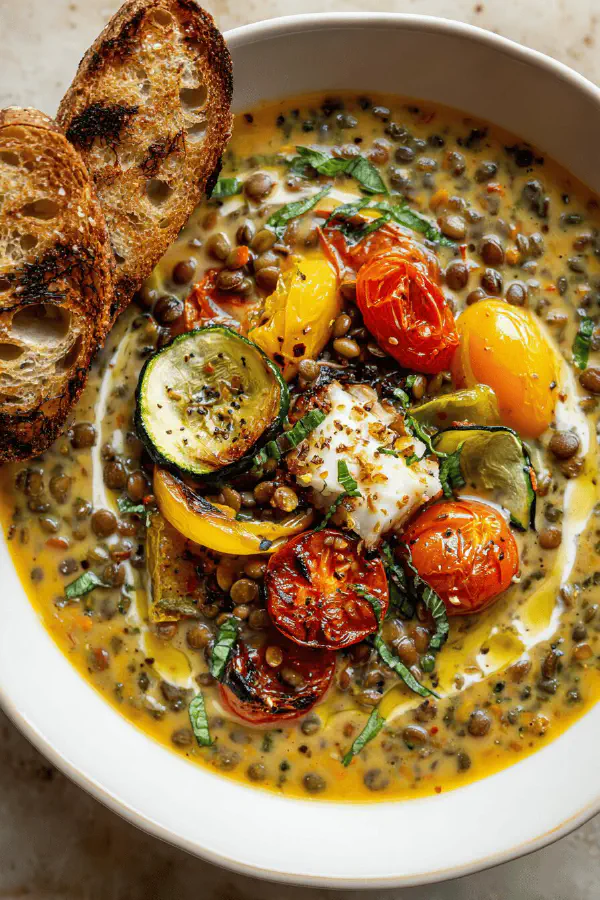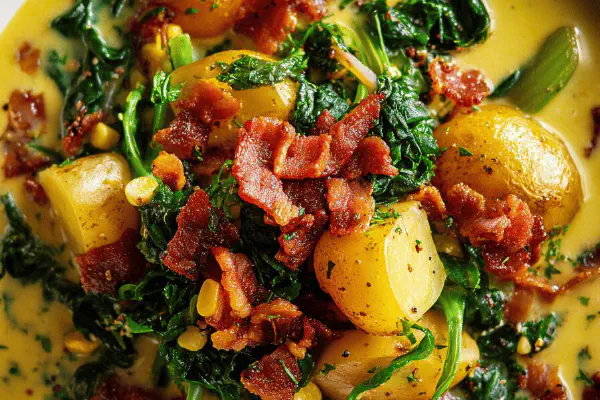Featured Recipe
Lentil Cream with Roasted Veggies

By Kate
"
A rich lentil and vegetable soup blending roasted seasonal produce with a touch of acidity and olive oil. Slow-simmered lentils tenderize until silk-like, pureed into a velvety cream. Uses chicken broth but swaps in mushroom broth for vegan/vegetarian option. Roasting the vegetables first adds caramelized depth, while balsamic vinegar cuts through the earthiness. Textures are silky within, punctuated by roasted vegetable aromas and a slight tang. Serve with crusty bread or vegan cheese alternative. Practical for meal prep or quick weeknight dinner with basic pantry staples.
"
Prep:
20 min
Cook:
30 min
Total:
50 min
Serves:
6 servings
soup
vegetarian
meal prep
Introduction
Lentils paired with roasted seasonal vegetables—hearty, humble, no-nonsense. Roasting builds an umami crust, caramel aromas fill kitchen, inviting patience. Tomatoes peel easily when warm, sweeter, stripping away bitterness of raw skin. Slow simmer softens lentils to silk, pureed for velvety texture. Acidic balsamic vinegar lifts earthiness, cutting fat from olive oil. A rustic meal, versatile. Swap in vegetables depending on season or fridge contents. Balancing seasonings vital—too bland, it’s just mush; too sharp, off-putting. Practical tips: pre-cook lentils to save time; roast veggies effectively; vinegar alternatives given. Serve with bread, cheese, herbs—simple satisfaction.
Ingredients
About the ingredients
Use fresh vegetables in peak condition for best caramelization. Diced zucchini and bell peppers release moisture, monitor roasting to avoid soggy texture — spread single layer with room to brown. Tomatoes must be peeled post-roast to prevent grainy bits in final soup. Lentils should be cooked separately to control doneness—pilaf method or canned drained. Broth choice impacts flavor—vegetable broth keeps recipe vegan; chicken broth adds depth but watch salt levels. Olive oil contributes richness over butter for dairy-free option. Vinegar choice affects acidity: balsamic for sweetness, sherry for dryness, apple cider for tartness. Adjust salt according to broth used.
Method
Roasting and prep
- Position oven rack center; preheat to 210°C (410°F). Toss zucchini, tomatoes, and bell peppers with balsamic and olive oil on rimmed baking sheet. Season with salt and pepper. Spread veggies evenly. Roast 18-22 minutes turning twice until edges char lightly and pieces soften but retain shape. Fragrance shifts from raw to roasted. Remove from oven; peel tomato skins off—they slip easily now. Chop tomato flesh coarsely.
- Bring broth to boil in medium pot. Drop in roasted vegetables and lentils. Reduce heat; simmer gently 4-7 minutes until all veg yield under light pressure and lentils break down further. Avoid boiling too hard to preserve aromatics; gentle bubbles only. Remove from heat. Blend contents in batches to a creamy texture using immersion blender or countertop blender. Add broth sparingly to adjust thickness. Soup should coat the back of a spoon with a luxurious mouthfeel—too thin loses body, too thick feels pasty.
- Taste for salt and pepper, balancing acidity from vinegar. Soups like these can flatten if under-seasoned; lift with an extra splash of vinegar or squeeze of lemon. Warm thoroughly if cooled. Ladle into bowls. Accompany with a wedge of aged cheese, or nut-free vegan soft cheese. Rustic bread like naan or country loaf ideal for dipping and cleaning bowl. Sprinkle freshly chopped herbs on top if available for freshness.
- If balsamic unavailable, substitute with sherry vinegar or apple cider vinegar for brightness. Bell peppers can be swapped with red or orange to vary sweetness. Lentils: green or brown works best, pre-cooked or canned saves time but drain well. For vegan, vegetable broth essential; omit cheese or use plant-based alternatives. Peeling tomatoes post-roast removes bitter skin—the texture refines the soup. Don’t skip roasting step; raw veg boil yields watery flavor.
- Soup too thin? Add an extra half cup lentils and simmer longer. Too thick? Stir in hot broth or water. Bitter taste? Likely from over-roasted garlic or skin; remove or strain. Lacking depth? A minute sauté of diced onion with olive oil at start amps flavor before roasting. Burnt veggies? Remove black bits as they darken broth unpleasantly. Save leftovers covered in fridge 3 days or freeze.
- Cook times approximate; focus on texture and aroma cues instead of strictly the clock.
Simmering and pureeing
Final seasoning and service
Substitutions and tips
Troubleshooting
Technique Tips
Roast vegetables first; caramelization unlocks deeper flavors, essential step for layered profile. Turn veggies at least twice during roasting for even browning and prevent steaming from trapped moisture. Peeling tomatoes is easier while warm; use paring knife if skin stubborn. Simmering gently retains aroma volatiles; rolling boil breaks down delicate flavors and causes bitterness. Puree soup batches in blender for smooth, no lumps; thin gradually—too much liquid dilutes taste and mouthfeel. Season at end to prevent flatness. Check texture visually and by spoon—should coat without dribbling like watery broth or clumping like thick paste. Add veggies or broth as necessary. Serve warm with fresh herbs or grated cheese, highlighting contrast. Save leftovers in airtight containers; freeze in small portions.
Chef's Notes
- 💡 Use seasonal veggies for depth. Fresh zucchinis. Ripe tomatoes. Bell peppers add sweetness. Room temp ingredients roast better, more flavor.
- 💡 Adjust broth to your taste. Chicken broth for richness; vegetable broth for vegan. Always check salt levels in broth first. Balance flavors.
- 💡 For quicker prep, use canned lentils. Drain fully before blending. If using dry, cook separately for consistency. More control, even texture.
- 💡 Monitor roasting time closely. Vegetables char but don’t burn. Turn regularly. Pay attention to their softness. Aroma shifts say they’re ready.
- 💡 Peeling tomatoes post-roast is simpler. Warm skins slip off easily. Leave skin; texture changes. Blend until velvety, avoid lumps or grittiness.
Kitchen Wisdom
How to thicken soup if too thin?
Add more lentils. Simmer until thickened. Or cook down, reducing broth slowly.
Best way to store leftovers?
Airtight container in fridge for 3 days. Freeze small portions too. Easy reheats later.
What if soup tastes flat?
Add more salt or vinegar to brighten. Adjusting for balance is key; don’t skip taste testing.
Alternatives for roasted veggies?
Swap seasonal. Carrots for sweetness; sweet potatoes for creamy texture. Just adjust cooking time.



